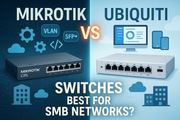
When you’re running a small to medium-sized business (SMB), your network is the backbone of your operations. Every email, file transfer, video call, or cloud application relies on it. And when it comes to building a reliable and high-performance network, two brands often lead the conversation — MikroTik and Ubiquiti.
Both brands have earned a loyal following for their quality, performance, and value for money, but they approach networking in very different ways. MikroTik is known for its advanced configuration options, hardware flexibility, and cost-effectiveness, while Ubiquiti is praised for its user-friendly interface, seamless integration, and centralized management.
Choosing between them isn’t just about picking a brand — it’s about finding the right tool for your specific needs. In this detailed comparison, we’ll explore what each brand offers, how they differ, and which one might be the best fit for your business.
Understanding the Role of Network Switches
Before we dive into the comparison, it’s worth taking a moment to understand why network switches are so important.
A switch connects multiple devices on a local area network (LAN), allowing them to communicate and share resources efficiently. In SMBs, a good switch ensures smooth communication between servers, computers, VoIP phones, IP cameras, and other connected devices.
Without the right switch, your network can suffer from bottlenecks, lag, or even downtime, which can affect productivity and, ultimately, your bottom line.
MikroTik CRS Switches — The Powerhouse for Advanced Users
The MikroTik CRS (Cloud Router Switch) series is a favorite among IT professionals who want full control over their network. These switches combine high-performance hardware with the powerful RouterOS software, allowing for both switching and routing functions in one device.
Key Advantages:
- Dual Functionality
CRS switches work as both a Layer 2 switch and a basic Layer 3 router. This means they can handle both simple switching tasks and more complex routing needs without requiring separate hardware. - Advanced Configuration
RouterOS gives you deep control over features like VLANs, routing protocols, firewall rules, and bandwidth management. You can fine-tune your network to match very specific requirements. - High Performance and Hardware Variety
Many MikroTik models include SFP+ ports for 10GbE fiber connectivity, making them ideal for high-bandwidth applications such as data centers or media production environments. - Cost-Effective
Compared to other brands offering similar features, MikroTik is highly budget-friendly, making it a popular choice for businesses that want maximum value without overspending.
Possible Drawbacks:
- Steeper learning curve for beginners.
- Interface may feel intimidating to those without networking experience.
Best For:
Businesses with in-house IT teams, advanced networking needs, or scenarios where fine-tuned control is a priority.
Ubiquiti UniFi Switches — Seamless Integration and Ease of Use
Ubiquiti UniFi switches are designed with simplicity and integration in mind. They fit perfectly into the broader UniFi ecosystem, which includes access points, routers, cameras, and more — all managed from one centralized platform.
Key Advantages:
-
Centralized Management
The UniFi Controller software allows you to configure, monitor, and manage all your UniFi devices from a single, user-friendly dashboard. This makes troubleshooting and updates much easier.
-
Beginner-Friendly Interface
Unlike MikroTik, Ubiquiti focuses on making setup as straightforward as possible. Even non-technical staff can perform basic management tasks with minimal training.
-
Excellent PoE Support
Many UniFi switches include Power over Ethernet (PoE), which means you can power compatible devices like IP phones, cameras, and access points directly through the Ethernet cable — reducing clutter and simplifying installation.
-
Reliable Performance
While Ubiquiti doesn’t typically offer as many configuration options as MikroTik, their hardware is optimized for stability and integration within the UniFi environment.
Possible Drawbacks:
-
Less customizable than MikroTik for advanced routing and network configurations.
-
Slightly higher cost for comparable hardware specifications.
Best For:
SMBs that value simplicity, centralized control, and seamless integration with other networking gear.
Side-by-Side Comparison
|
Feature |
MikroTik CRS Switches |
Ubiquiti UniFi Switches |
|
Configuration Control |
Advanced (RouterOS) |
Simple, GUI-based |
|
Management |
Per-device configuration |
Centralized UniFi Controller |
|
Performance |
High — SFP+ and multi-gig options |
High — Optimized for UniFi ecosystem |
|
Ease of Use |
Steeper learning curve |
Very beginner-friendly |
|
Cost |
Budget-friendly per feature |
Slightly higher but worth the simplicity |
|
PoE Support |
Available on select models |
Wide PoE support across most models |
|
Ideal For |
Power users, complex networks |
SMBs, integrated networks |
Which One Should You Choose?
Choose MikroTik if:
-
You want maximum customization and advanced features.
-
You have (or can hire) IT staff who can configure and maintain the network.
-
You want high-speed connectivity with SFP+ support at a budget-friendly price.
Choose Ubiquiti if:
-
You prefer an easy-to-use, plug-and-play network solution.
-
You want centralized management for all networking devices.
-
You plan to build an ecosystem of Ubiquiti products for seamless integration.
Final Thoughts
Both MikroTik CRS and Ubiquiti UniFi switches are excellent products, but they are designed for different types of users. MikroTik offers incredible flexibility and value for tech-savvy professionals, while Ubiquiti delivers simplicity and ease of management that many SMB owners love.
The choice ultimately depends on your technical comfort level, budget, and long-term network goals. If you prioritize fine-tuned control and cost efficiency, go for MikroTik. If you want centralized management and ease of use, Ubiquiti might be the better investment.







